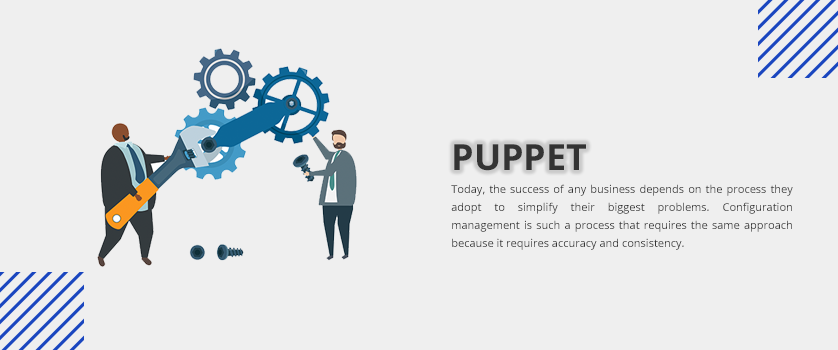


Puppet
Today, the success of any business depends on the process they adopt to simplify their biggest problems. Configuration management is such a process that requires the same approach because it requires accuracy and consistency. Contrary, most organizations do it in a different way using manual configuration management methods.
Can a system administrator manage hundreds or thousands of systems manually with accuracy and consistency? Well, it is possible to an extent but no one can deny the stress level of system administrators and its effect on the overall infrastructure. Keeping all these problems in mind, Puppet has built its configuration management tool.
This system management tool automates and centrally manages the configuration management process. Plus, it can be used for software deployment. To know more about Puppet and its working, let’s understand its components first.
Master: Puppet master plays a significant role in handling the configuration related process because it holds the necessary information regarding the configuration and with the help of Puppet agent, this information is passed on to the nodes.
Slave or Agent: It runs on the client machine and managed by the Puppet master
Manifests: It’s a file that contains the configuration details for the Puppet Slave. The extension .pp is used for manifest files which means Puppet policy. These files hold the configuration scripts to configure the Slave.
Module: It is a set of manifests and data - files, facts, or templates. To store this information, the module uses a specific directory structure that later on splits into multiple manifests. In other words, we can call modules self-contained bundles of data or code.
Resource: It’s a basic unit of system configuration modeling, predefined functions that run in the background to perform the specific operations on the Puppet. Each resource has a particular element of the system like a service or package.
Factor: These factors are used to assess the present state of any agent and to make changes to the target machine. Factors collect crucial information about the Puppet Slave and the master. The role of the factor is to represent the Puppet client as the operating system, network interface, uptime, IP address, or to find out whether the client machine is virtual or not.
M-collective: It is a framework used to run parallel execution of several jobs on multiple Slaves. This framework can be used to:
M-collective ensures that all these tasks can be performed together.
Catalog: All the configuration and manifest files are compiled into a catalog, and then applied to the target machine. Also, the required states of Slave resources are described in the catalog.
Class: To organize the Puppet code in a better way, the Puppet supports a class that is a collection of various resources that are grouped into a single unit.
Nodes: It is the location of the Puppet Slaves that are used to manage all the clients and servers.
Puppet works on the master-Slave architecture, a secure and encrypted channel to communicate with the help of SSL.
The Puppet-master is installed on the main server to help all clients to deploy, configure, and maintain the infrastructure. While the Puppet agent installed on the clients communicate with the Puppet master to fetch configuration instructions. Puppet provides flexibility to install specific software and monitor the state of the system continuously. Puppet is written in Ruby and uses Domain-Specific Language (DSL) to define configuration parameters for a specific environment or infrastructure.
Open-Source Platform: Besides pre-installed features, Puppet allows you to build custom libraries and modules exclusively for a project. Plus, it has an active community of forums, discussion boards, and experts to help you out in difficult circumstances.
Real Assistance for Administrators: With Puppet, administrators can shift their focus from mundane to productive tasks. By spending lesser time and effort, they can manage servers efficiently. Its declarative language is as easy as XML, and a person with limited skills in programming can easily learn it.
No More Redundancy: In a large environment of systems and servers an administrator may repeat some activities but with Puppet’s ‘idempotency’ feature such instances can be avoided. If the change is already done, then this feature will not make further tweaks to it.
Cross-Platform Tool: Puppets’s users can cover a range of servers that including Fedora, RHEL, Debian, Gentoo, Solaris, OS X, and Windows. It means that more servers can be configured using a single tool.
Swisscom, a major telecommunication organization in Switzerland, faced the challenge of managing hybrid infrastructure with different configuration setups. In such distinct environments, system administrators had to write scripts for each environment and the entire IT team’s focus was on the manual process. It didn’t take much time for Swisscom to conclude that they needed a solution to manage their infrastructure effectively while simultaneously spending less.
So they implemented Puppet Enterprise and witnessed remarkable results that include:
Swisscom is not the only organization that transformed the configuration management using Puppet. Google, Spotify, and various other businesses have also used Puppet.
Puppet is a powerful tool that helps you with configuration management and brings consistency across the infrastructure. It is easy to use and saves system administrators from unnecessary stress. If you want to take your business to new heights by ensuring efficiency and savings, then Puppet is worth trying.